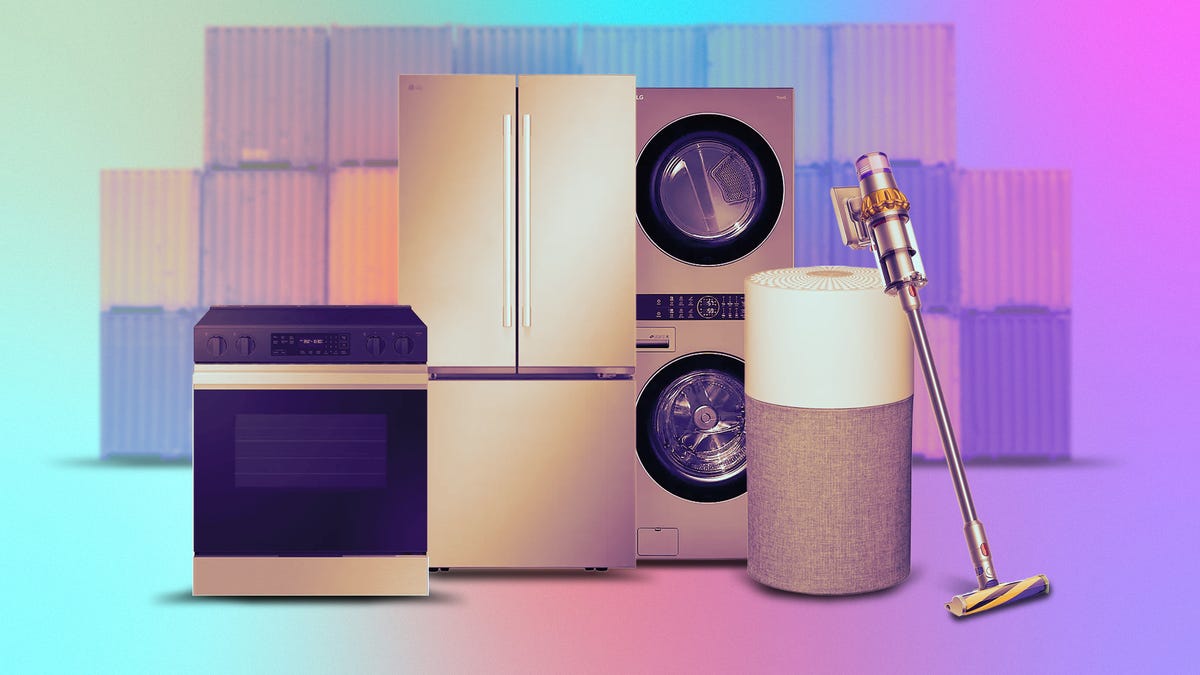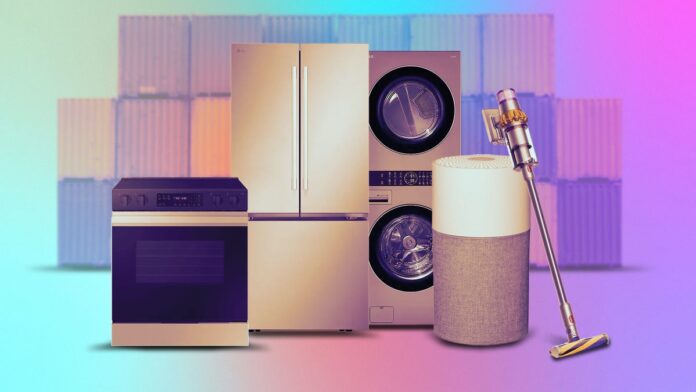
Trump’s new steel and aluminum tariffs could increase the price of appliances.
Key takeaways
- Tariffs imposed by the Trump administration, including the recently doubled 50% tariff on imported steel and aluminum products are expected to drive up prices for home appliances.
- Appliances with imported components and those assembled outside of the US, like refrigerators, dishwashers and washing machines, are especially vulnerable to price hikes due to tariffs.
- Smart appliances may face even higher price increases if additional tariffs are placed on semiconductor chips.
- Experts recommend purchasing necessary appliances sooner rather than later to avoid price hikes and suggest looking to sales to save money.
Over the last few months, you’ve probably heard more than you ever have about tariffs. Tariffs have been a big focus of President Donald Trump’s second term and many companies have announced price hikes to offset tariff costs.
Trump recently announced new 50% tariffs on steel and aluminum imports last week, a move that could hit home appliances particularly hard.
“We expect home appliance prices to rise this year, especially for mid-range and premium models that rely heavily on imported parts and materials,” said David Warrick, executive vice president at Overhaul, a supply chain management platform, and former head of global supply chain technology at Microsoft.
Larger home appliances could be the most susceptible to price hikes. “Refrigerators, dishwashers and washing machines are particularly vulnerable because they often include a high percentage of foreign components — even when final assembly happens in the US,” said Warrick.
CNET has been covering the Trump administration’s tariff policy and changes, and we’ve already seen manufacturers and retailers raise prices on laptops, toys and groceries. Before you panic-buy a home appliance, here’s what you need to know about tariffs and how they could increase appliance prices this year.
How do tariffs impact home appliance prices?
We could see home appliance prices rise on products that are made in countries hit with tariffs. Because tariffs are paid by the importing company, the costs are typically passed along to the consumer in the form of higher prices, although the price hike may not be a 1-to-1 ratio with the tariff rate.
The tariffs that most threaten home appliances include the 50% tariff on all steel and aluminum imports, the 25% tariff on imported goods from Mexico and Canada and the 30% tariff on imports from China. Higher tariffs on Mexico, Canada and China have been temporarily halted but this could change in the coming months.
Tariffs don’t only apply to assembled products that are made elsewhere and then shipped here to be sold. Many products that are assembled in the US involve imported components.
Materials like steel and aluminum are often imported, as are pumps, motors and hoses, so appliances that include those parts could see notable price increases, according to Travis Tokar, a professor of supply chain management at Texas Christian University.
How tariffs impact home appliance prices could also vary depending on the type of appliance, the size and where it’s manufactured.
“A lot of this will depend on the agreement with Mexico since many large appliances are assembled in Mexico,” said Patti Jordan, associate professor of professional practice at the Neely School of Business. “Product[s] manufactured primarily in China, such as vacuum cleaners, air purifiers and small appliances, will most definitely be impacted.”
The Trump administration has also wavered on its tariff policy, making it difficult for the industry to predict what’s next. “It’s the off-and-on tariff strategy that is leading to the supply chain instability more so than the tariffs — at least so far,” Buffington added.
Could smart home appliances see even higher price hikes?
There’s been talk of separate semiconductor tariffs from the Trump administration that could impact the prices of anything with a smart chip in it, including laptops and smart home tech. If initiated, an additional tariff on semiconductors could raise the cost of smart appliances even more.
“Smart appliances will absolutely feel the squeeze if semiconductor tariffs are implemented,” Warrick said. “These products — think smart fridges, ovens, robotic vacuums — depend on imported chips and modules. The more ‘smart’ tech built into an appliance, the more exposed it becomes.”
Shawn DuBravac, CEO and president at Avrio Institute, a business technology research firm, added that lower-priced home appliances that use semiconductor technology might face even bigger price increase percentages, because these items have lower margins and are less able to absorb price increases.
Experts also noted that it would be difficult for the government to know when a product has a semiconductor chip and price it appropriately. “Managing this would seem to be impossible,” said Jack Buffington, associate professor in supply chain management at the University of Denver. “How would customs be able to determine which products have chips, where they are from, and would there be a tariff by chip or just one tax for any product with one chip?”
Since verifying semiconductor would be complicated, DuBravac thinks it’s possible that home appliances, particularly those fully manufactured outside of the US, might avoid separate semiconductor tariffs altogether and instead be taxed at their product category rate for the exporting country.
“However, home appliances that are manufactured in the US would likely face semiconductor tariffs if the component is imported,” DuBravac added.
Tariffs aren’t the only reason we’ll see appliance price hikes
Experts expect home appliance prices to rise but tariffs aren’t the only culprit. Companies are also looking at other costs when deciding whether to hike prices.
“There are many factors that impact the price of a product besides a new tariff. Transportation costs, labor costs and material costs. Appliance manufacturers have to weigh in on the impact of each of these in order to determine the pricing of their product going forward,” said Jordan.
Which home appliances will see the biggest price hikes from tariffs?
It’s difficult to predict which way the Trump administration will take its tariff strategy. Based on what’s currently implemented and future proposals, experts say the following appliances could see price hikes:
Appliances with smart technology, like smart refrigerators or smart washers and dryers could see further increases if additional semiconductor tariffs are imposed. Here’s how high prices could rise for each type of home appliance.
OK, appliance prices will likely rise. Should I buy now or wait?
Currently, the higher tariff pause for China is set to expire on Aug. 12. Most air purifiers would be exempt from the 25% tariffs on Mexico, but this agreement is also set to expire in July. Steel tariffs rose from 25% to 50% on June 4.
That makes it tricky to decide if you should purchase a new appliance now or wait to see how President Trump’s tariff war pans out.
“It is somewhat a roll of the dice,” said Jordan. “Right now, much of the inventory came into the US before the tariffs hit so now might be the right time to buy if it is in stock.”
DuBravac agrees. “My advice is: If you know you’ll need it soon, buy now. Prices are more likely to rise than fall in the near term as tariff policy uncertainty looms and importers adjust inventory strategies. Waiting could mean paying more later.”
That doesn’t mean you should panic-buy a new appliance, though. Experts suggest turning to sales like Prime Day and Black Friday to help offset any cost increases.
If you know you’re going to need a new appliance this year, work toward building a sinking fund — a short-term savings plan — and contribute money toward your fund with each paycheck. If you need to finance a purchase, factor in how much interest charges could add to your purchase. Interest rates are still high so if you put the purchase on a credit card and can’t pay it off in full in one to two months, you might end up paying more than what a tariff would cost you.
Întrebări frecvente
Can buying secondhand appliances save you money?
Cel/Cea/Cei/Cele second-hand shopping market has reignited in the wake of Trump’s tariffs and it could be a good way to compromise and fit an appliance purchase into your budget this year.
Experts don’t expect the secondhand market to see price hikes directly from tariffs but note that it’s possible if the demand for secondhand products increases.
“The secondhand market is a viable way to save — at least in the short term,” said Warrick, “As new appliance prices rise, more consumers will start considering used options, which could push up demand and eventually prices in that space too. But for now, it’s a smart way to avoid tariff-driven sticker shock, especially for larger or smarter appliances.”
Shopping secondhand or repairing broken appliances won’t always save you money, either. Purchasing an older model or fixing certain appliances could cost you more than the machine is worth, said Buffington. “For example, washing machines are around $400 to $1,000 so fixing an appliance or buying something that’s 5 years old may not make sense if the lifespan is 10 years.”
Is buying US-assembled appliances a viable option?
Trump says one of the goals of his tariff policies is to encourage companies to ramp up manufacturing in the US. However, it’s not as simple as flipping a switch. Shifting manufacturing from overseas to the US would take time — and it has its own set of costs that could impact prices.
“Clearly, the hope is that all these changes will lead to more ‘Made in the USA’ products, but in reality we don’t have prepared industries to step in and begin producing these goods,” said Josh Fischer, VP of product strategy at Cin7, an inventory management software developer. “It’ll take years before we benefit from these changes, if at all.”
While you can find appliances that are assembled in the US, it doesn’t mean all of their parts were manufactured here. Many have components that are imported from other countries, which could hike up the price tag regardless of where it’s assembled.
“What’s happening in appliances is a microcosm of the larger supply chain story,” Warrick said. “Tariffs don’t just affect finished goods; they affect parts, sub-assemblies and even packaging. So even if a product is ‘Made in America,’ if it contains foreign components, it’s still vulnerable.”


